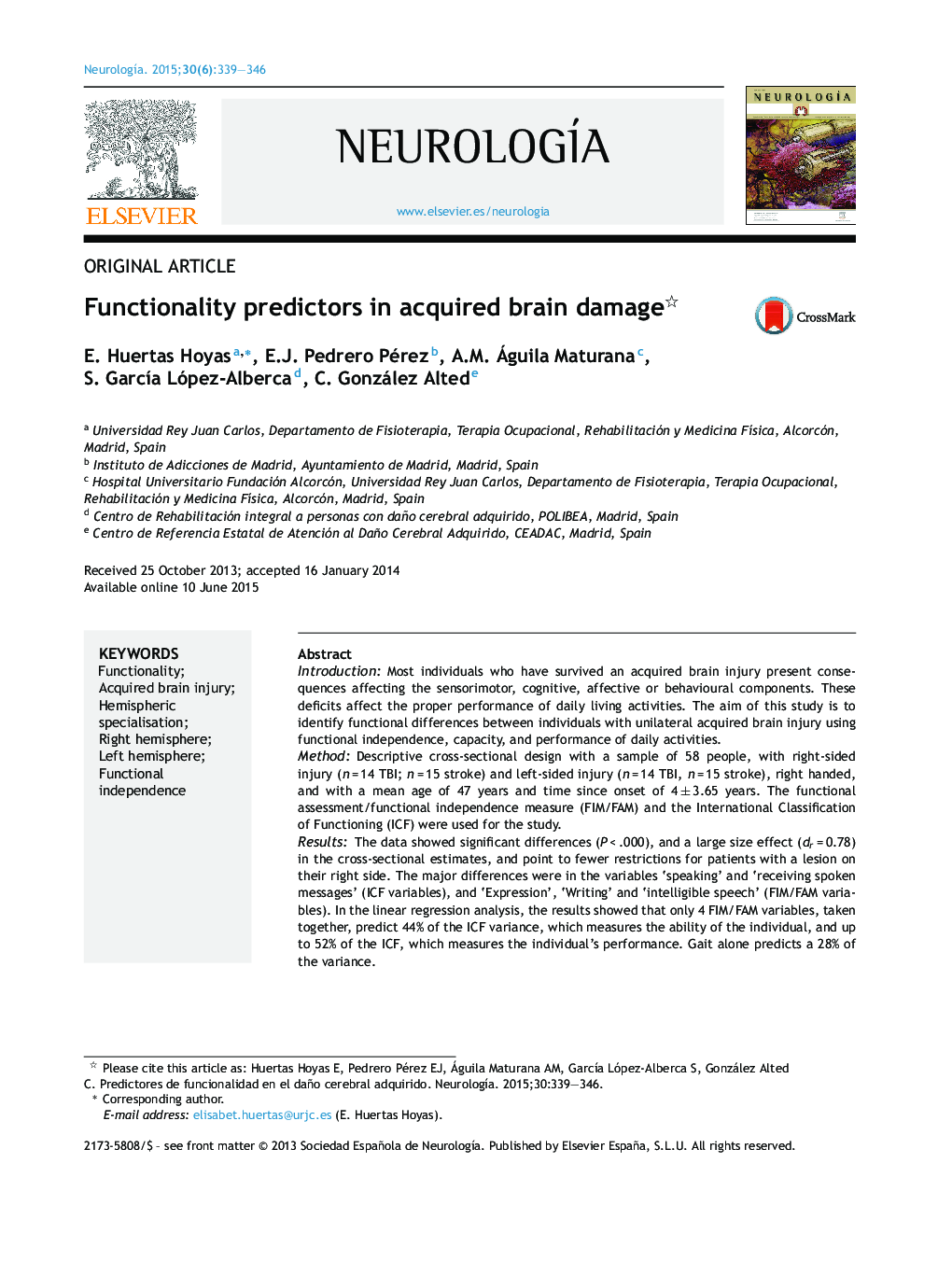| کد مقاله | کد نشریه | سال انتشار | مقاله انگلیسی | نسخه تمام متن |
|---|---|---|---|---|
| 3077245 | 1189130 | 2015 | 8 صفحه PDF | دانلود رایگان |
IntroductionMost individuals who have survived an acquired brain injury present consequences affecting the sensorimotor, cognitive, affective or behavioural components. These deficits affect the proper performance of daily living activities. The aim of this study is to identify functional differences between individuals with unilateral acquired brain injury using functional independence, capacity, and performance of daily activities.MethodDescriptive cross-sectional design with a sample of 58 people, with right-sided injury (n = 14 TBI; n = 15 stroke) and left-sided injury (n = 14 TBI, n = 15 stroke), right handed, and with a mean age of 47 years and time since onset of 4 ± 3.65 years. The functional assessment/functional independence measure (FIM/FAM) and the International Classification of Functioning (ICF) were used for the study.ResultsThe data showed significant differences (P < .000), and a large size effect (dr = 0.78) in the cross-sectional estimates, and point to fewer restrictions for patients with a lesion on their right side. The major differences were in the variables ‘speaking’ and ‘receiving spoken messages’ (ICF variables), and ‘Expression’, ‘Writing’ and ‘intelligible speech’ (FIM/FAM variables). In the linear regression analysis, the results showed that only 4 FIM/FAM variables, taken together, predict 44% of the ICF variance, which measures the ability of the individual, and up to 52% of the ICF, which measures the individual's performance. Gait alone predicts a 28% of the variance.ConclusionsIt seems that individuals with acquired brain injury in the left hemisphere display important differences regarding functional and communication variables. The motor aspects are an important prognostic factor in functional rehabilitation.
ResumenIntroducciónLa mayoría de las personas que han sobrevivido a un daño cerebral presentan secuelas que afectan a componentes sensoriomotores, cognitivos, emocionales o conductuales. Estos déficits repercuten en la correcta ejecución de actividades de la vida diaria. El objetivo de este estudio es identificar diferencias funcionales entre personas con daño cerebral adquirido (DCA) unilateral, mediante la independencia funcional, la capacidad y la realización de las actividades cotidianas.MétodoDiseño transversal descriptivo con una muestra de 58 personas con lesiones derechas (n = 14 TCE, n = 15 ECV) e izquierdas (n = 14 TCE, n = 15 ECV), diestros, con una media de edad de 47 años y una media de 4 ± 3.65 años de evolución. Las medidas utilizadas fueron la FIM FAM y la CIF.ResultadosLos datos apuntan hacia la existencia de diferencias significativas (P < 0.000) y un elevado tamaño del efecto (dr = 0.78) en las estimaciones transversales, otorgando una menor restricción en la participación en las personas con lesión derecha. Las diferencias más destacadas se encuentran en las variables “recepción de mensajes hablados”, “escritura” y “habla inteligible”. Al hacer una regresión lineal, los resultados muestran que solo 4 variables de la FIM FAM predicen, en su conjunto, un 44% la variancia de la CIF que mide la capacidad del individuo y hasta un 52% de la CIF que mide la realización del sujeto. Tan solo la marcha predeciría un 28% de la variancia.ConclusionesSe sugiere que las personas con DCA en el hemisferio izquierdo presentan importantes diferencias en variables funcionales y de la comunicación. Los aspectos motores representan un gran factor pronóstico para la rehabilitación funcional.
Journal: Neurología (English Edition) - Volume 30, Issue 6, July–August 2015, Pages 339–346
